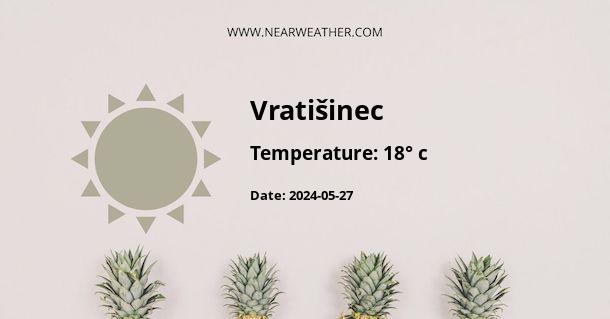Understanding the Climate and Weather Patterns of Vratisinec, Croatia
Vratisinec, a captivating locale nestled in the picturesque landscapes of Croatia, offers a unique climate that mirrors the diverse natural beauty of the region. To understand the climate and weather year-round in Vratisinec, it is vital to delve into various meteorological elements that influence the area. This includes temperature fluctuations, precipitation levels, wind patterns, and other atmospheric conditions that combine to create the distinct seasons experienced in this region.
Geographical Influence on Vratisinec's Climate
The climate in Vratisinec is shaped by its geographic position. Located in the northern part of Croatia, Vratisinec falls within a temperate continental climate zone. This zone is characterized by warm summers and cold winters, with a significant temperature disparity between these seasons. The proximity to the Adriatic Sea, although more influential in coastal regions, does have a subtle impact on the area's climate, adding a touch of Mediterranean mildness to the otherwise continental attributes.
Temperature Overview
Summer Climate
Summers in Vratisinec are typically warm and pleasant, with average high temperatures ranging from 25°C to 30°C (77°F to 86°F). Nighttime temperatures during the summer months tend to be cooler, dropping to comfortable ranges that provide respite from the daytime heat.
Winter Climate
The winter season brings forth a stark contrast, with temperatures often dipping below freezing. Average high temperatures hover around 1°C to 3°C (34°F to 37°F), while nighttime lows can plummet to -5°C to -10°C (23°F to 14°F), occasionally bringing snow and frost to the landscape.
Transition Seasons
- Spring: Spring marks the transition from the brisk winter to the mild summer. This season is characterized by increasing temperatures and fluctuating weather patterns, as the thaw begins in earnest.
- Autumn: Similarly, autumn serves as a transition from the warm summer back into the colder winter. It features declining temperatures and increasing precipitation, often with warm spells known locally as "Indian summers."
Precipitation Patterns
| Month | Average Precipitation (mm) |
|---|---|
| January | 35 |
| February | 30 |
| March | 40 |
| April | 55 |
| May | 75 |
| June | 90 |
| July | 80 |
| August | 80 |
| September | 85 |
| October | 80 |
| November | 85 |
| December | 55 |
Note: The table above shows average precipitation values which are subject to change due to climate variability and patterns such as the North Atlantic Oscillation or the impacts of global climate change.
Wind and Atmospheric Conditions
Wind conditions in Vratisinec are often influenced by larger atmospheric patterns affecting Europe. Predominant wind directions can vary throughout the year, with certain weather fronts bringing in colder or warmer air masses. For instance, the Bora wind, a cold and dry northeasterly wind, can influence the weather conditions during the winter and early spring, leading to clearer skies but cooler temperatures.
Extreme Weather Events
While Vratisinec generally enjoys a moderate climate, it is not impervious to extreme weather events. Summer months can sometimes produce heatwaves, where temperatures rise significantly above average. Conversely, winter can usher in extreme cold snaps. Additionally, thunderstorms, particularly in the warmer months, can occur, bringing with them heavy rainfall and, on occasion, hail.
Year-Round Weather Considerations for Visitors and Residents
- Pack Adequately: Individuals planning a visit or move to Vratisinec should be prepared to pack a diverse wardrobe, with lighter clothes for the summer and warm, insulated apparel for the colder winter months.
- Driving Conditions: Those who intend to drive during the winter should be prepared for potential icy roads and ensure their vehicle is equipped with winter tires or chains when necessary.
- Outdoor Activities: The transitional seasons of spring and autumn are excellent for outdoor activities, offering mild temperatures and the beauty of the changing flora.
- Heating and Cooling: Residents should ensure adequate heating systems for the winter months and consider cooling solutions for the potentially high summer temperatures.
Climate Change Considerations
It's important to note that climate change is having a noticeable impact on weather patterns globally, and Vratisinec is no exception. Trends indicate alterations in precipitation distribution, the intensity and frequency of extreme weather events, and shifting seasonal norms. Continuous research and local climate initiatives are essential in understanding and adapting to these changes for the future of the region.
Conclusion
Vratisinec's climate, characterized by its warm summers and cold winters, is a testament to the diverse meteorological influences that impact this Croatian jewel. Understanding the area's weather patterns is crucial for both the local population and visitors, to ensure a harmonious coexistence with nature's rhythm. Whether one seeks to bask in the summer sun or marvel at the winter frost, Vratisinec offers a climate rich in variety and experience.
A - Vratišinec's Latitude is 46.478062 & Longitude is 16.457781.
A - Weather in Vratišinec is 14° today.
A - Climate Conditions in Vratišinec shows light rain today.
A - Humidity in Vratišinec is 24% today.
A - Wind speed in Vratišinec is 4.82 km/h, flowing at 116° wind direction. today.
